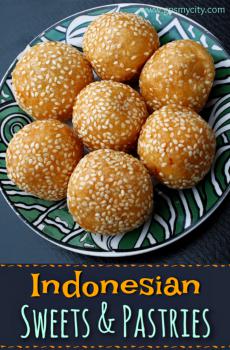
Indonesian Sweets and Pastries
Spread across an archipelago of islands accommodating hundreds of ethnicities speaking many different languages, Indonesia is a cluster of just as many culinary traditions. And just as any other Asian culinary, Indonesian cuisine can't be imagined without a dollop of sweetness. Some of the local delights, over the course of centuries, have found a place in Western cooking, while others are still an exotic rarity. To acquaint yourself with the most notable of Indonesian desserts, follow this guide and expand your taste horizons!
(To visit the venues mentioned in this article, check out these Self-Guided Walking Tours in Jakarta)
Image Courtesy of: PL09Puryono
1. Martabak Manis (Sweet Martabak) or Terang Bulan
-or-terang-bulan.jpg)
Image Courtesy of: Sakurai Midori
Of all the names this snack goes by (including “Terang Bulan”), Martabak Manis is certainly the one that everyone in Indonesia understands well without confusion. The local spin on a pancake, baked in a pan – pretty much like a crepe, only thicker (more like a crumpet) – it is sweet and spongy on the inside, while crispy on the outside, plus covered in butter or margarine, plus lots of other stuff on top, such as chocolate sprinkles (sometimes even Kit Kat or Nutella spread come into play), crushed peanuts, cheese (or cream cheese), green tea powder (matcha), and more. Prior to serving, martabak is folded in half, so that its toppings end up in the middle. The locals distinguish Sweet Martabak from Egg Martabak (Martabak Malabar). If you've had enough of savoury food, martabak is a good choice!
2. Kue Lapis (steamed) and Kue Lapis Legit (baked)
-and-kue-lapis-legit-(baked).jpg)
Image Courtesy of: Pudding4brains
This traditional Indonesian multi-layered, puffy, spiced cake is easily recognizable by its color stripes (white, green, and red); and it has two varieties: Kue Lapis (steamed pudding) and Kue Lapis Legit (baked layered cake). The latter's ingredients include butter, egg yolks, wheat flour, milk powder, icing sugar and a mix of spices, also known as "spekkeok powder," comprising cardamon, cinnamon, clove, mace and anise. Some variations of Lapis Legit may also include almonds, cashew nuts, cheese, prunes or raisins, and even chocolate and pandanus. While Kue Lapis Legit comprises multiple layers baked separetely and then pressed together for a firm texture, Kue Lapis is a moist, steamed layered pudding made of rice flour and sago. The white color in the cake comes from rice flour and starch; green - from pandan; and red - from a mixed red rose syrup. Each colored layer has the same thickness as a must. In the Netherlands, where this cake also has been popular since the colonial times, it goes by the name of "Spekkoek" which literally means a "pork belly" or "bacon cake" due to its resemblance to the dark and light layers of bacon.
3. Kue Klepon
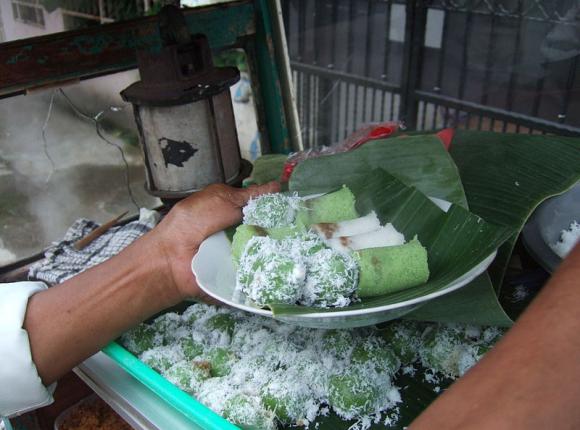
Image Courtesy of: Midori
A popular delicacy throughout Indonesia, Kue Klepon are adorable little balls (quite similar to Onde-Onde) made of boiled glutinous rice flour and pandan paste. Each ball is coated in delicious, freshly grated coconut flakes, and stuffed with succulent, liquid brown palm sugar that bursts in your mouth with a load of sweetness. Just pop one into your mouth and feel for yourself. Dangerously delicious! To counterbalance the sweetness, it is best enjoyed with a cup of black coffee.
4. Pisang Goreng
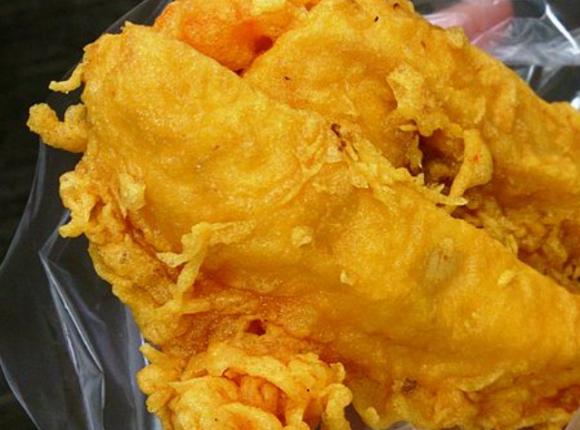
Image Courtesy of: ProjectManhattan
Introduced by the Portuguese as a breakfast staple, back in 1511, today Pisang Goreng ("fried banana") is a much loved afternoon snack in Indonesia which, just as the name suggests, represents a banana or plantain (cooking banana) coated in batter (optionally), and deep fried in oil to a crisp. Pisang Goreng is best enjoyed freshly cooked – either plain or with a dash of sugar, jam, condensed milk, chocolate or a generous dollop of Nutella spread on top. Alternate replacement to a banana could be cassava or tempe. Pisang Goreng is fairly easy to make at home.
5. Bika Ambon
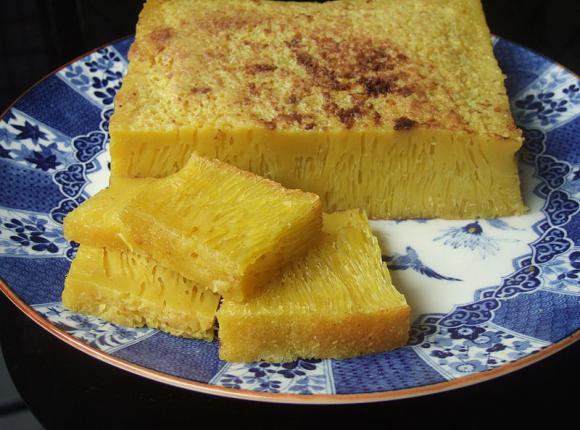
Image Courtesy of: Midori
Bika Ambon is a specialty cake made of tapoica and sago flour, eggs, sugar, coconut milk and yeast (the latter gives it a unique spongy texture, full of bubbles). The most common flavor here is pandanus, although other flavors, such as banana, durian, cheese or chocolate, are also possible. Contrary to its name, Bika Ambon originates in Medan, North Sumatra, which is nowhere near the Ambon province.
6. Onde-Onde
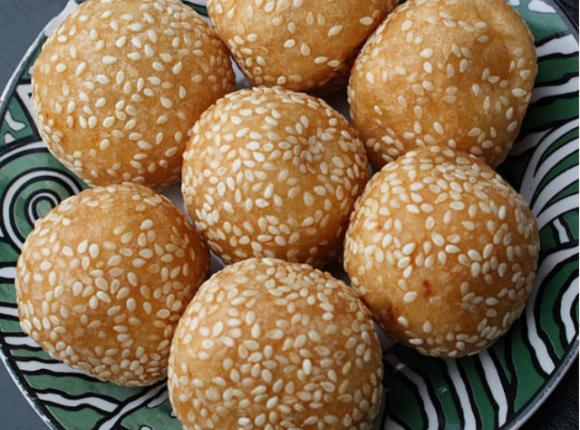
Image Courtesy of: PL09Puryono
Originated in China back in the 7th century AD, the Onde-Onde fried pastry balls were initially known as Jian Dui. Today, this snack is popular throughout Indonesia for its chewy and crispy texture. Made of wheat or glutinous rice flour, the balls are normally filled with a cooked green mung-bean (or lotus) paste, which sometimes may be replaced (in some fusion versions) with corn, cheese, chocolate or gooey salted egg yolk filling, and sprinkled with sesame seeds. A combination of golden, crunchy outer crust with a soft inner texture is what makes Onde-Onde particularly enjoyable and luring for a bite!
7. Kue Cucur
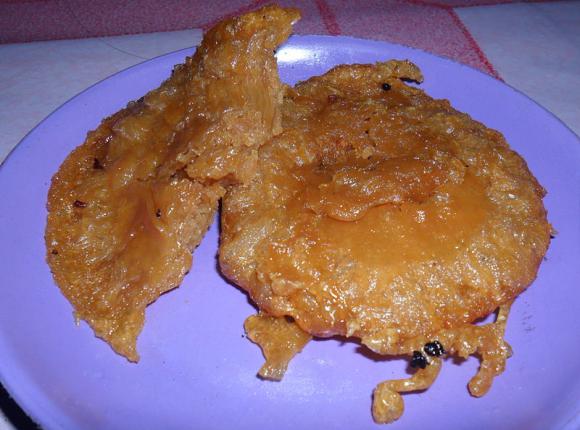
Image Courtesy of: Ezagren (bicara / talk)
Kue Cucur is a traditional Indonesian pancake with the batter made of rice flour, palm sugar and coconut milk. Renowned for its spongy texture and sweet taste, the most popular version of Kue Cucur comes from the Betawi people of Jakarta.
8. Bolu Kukus/ Kue Mangkok (Bowl Cake)
.jpg)
Image Courtesy of: JV06Iriana Famuji Widodo
Bolu Kukus ("steamed cake"), also known as Kue Mangkok (“bowl/cup cake"), is a steamed bun whose main ingredients include wheat or rice flour, tapioca, yeast, baking powder, eggs, coconut milk, sugar, salt, as well as vanilla essence or chocolate. It is quite similar to a muffin in terms of texture. The cake dough is placed inside a tin or cupcake container and then steamed until the top part rises, expanding and blossoming like a flower. This traditional Indonesian snack is best enjoyed with a cup of tea in the afternoon.
9. Kue Putu Ayu
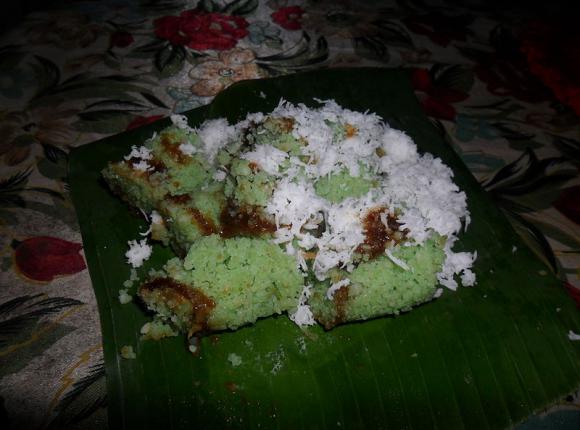
Image Courtesy of: Ezagren (bicara / talk)
Kue Putu [Putri] Ayu means a "putu cake" which is, in fact, a round cake with a hole in the middle. It is made of flour, sugar, eggs, pandan leaf, and salt, and traditionally served with grated coconut. It usually comes in white or green color, has a sweet taste and distinctive aroma (thanks to the pandan leaf present). The varieties of Kue Putu include Putu Mayang and Putu Bambu. The former ("string hoppers") resembles a ball of noodles of various colors, served with palm sugar on a side. As regards Putu Bambu, it has a cylinder shape and is filled with red coconut sugar.
10. Kue Wajik
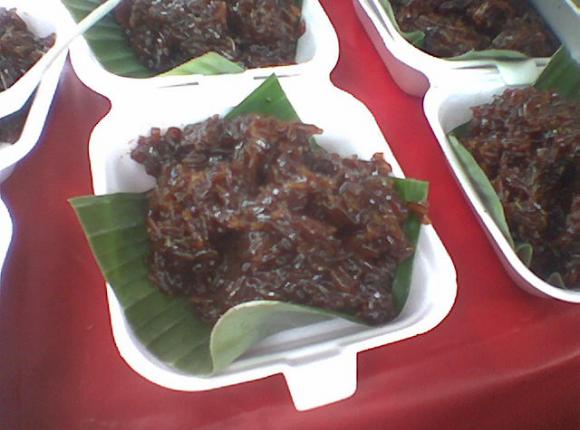
Image Courtesy of: Yosri
If you have a relish for glutinous rice, then Kue Wajik is for you. It is made mostly of glutinous rice, added with pandan leaves (for flavor) and coconut milk, sweetened with palm sugar (that gives it a distinctive brown color), and then compressed in a container and steamed. The snack bears a great deal of cultural significance for Indonesia and particularly for the Javanese people. In Java, Kue Wajik plays an important role in the communal feasts symbolizing social unity: celebrating births, marriages, etc.
11. Dadar Gulung
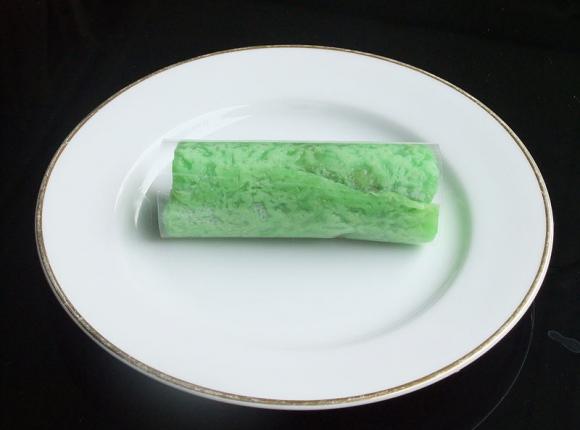
Image Courtesy of: Midori
Dadar (Indonesian for “pancake”) and Gulung (“roll”) is a green pancake made of rolled pandanus leaves, filled with sweet grated coconut. This is one of the most popular snacks in Indonesia, especially in Java. It is served in restaurants of all kinds including small warungs, cafes, steakhouses and even high end restaurants.
12. Cendol in a Glass
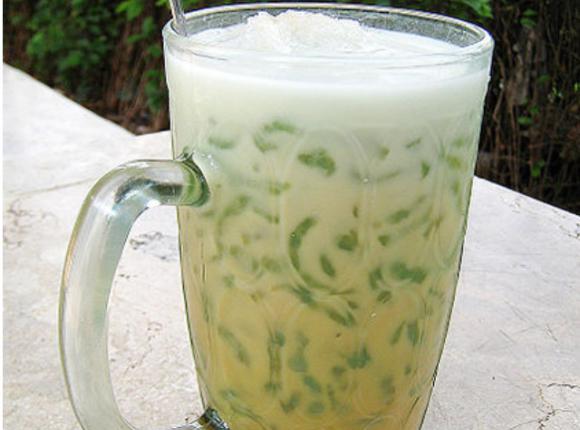
Image Courtesy of: Gunawan Kartapranata
This seemingly simple dessert – made up of just a few ingredients – is originally from Indonesia, but nowadays much popular throughout the entire Southeast Asia. Cendol's basic ingredients consist of creamy coconut milk, green rice flour noodles (worm-like and jelly, without much flavor, but with a nice chewy texture, the green color being derived from the pandan leaf), shaved ice, and palm sugar syrup. Other optional ingredients include red beans, glutinous rice, grass jelly, and creamed corn.
13. Es Kacang Merah (Red Peanut Ice)
.jpg)
Image Courtesy of: Andy Tsai
A very healthy snack, Es Kacang Merah is equally good for the old and young, particularly the kids in need of a height boost. Rich in protein, this traditional dessert of Sulawesi (“red bean/peanut ice” in English) contains syrup and red beans mixed together with milk. It is very beneficial for body metabolism, and especially for brain activity boosting.
14. Kue Ape
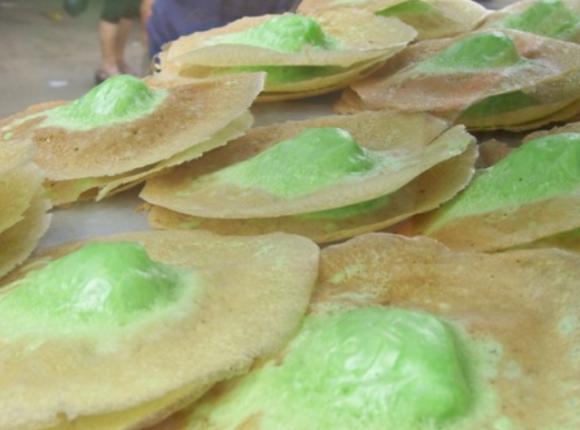
Image Courtesy of: Serenity
Another healthy snack brought to us by the Betawi people of Jakarta, Kue Ape (“ape” means “cake” here and has nothing to do with primates) is also known as Kue Apem or Kue Apam. Quite similar to Serabi Solo snack in appearance, this cake is more like a crepe – thin, crispy and browny on the sides, while soft, fluffy and green in the middle. Its main ingredients include rice flour, coconut milk, yeast and palm sugar. Kue Apem is usually served covered in grated coconut.
15. Dodol
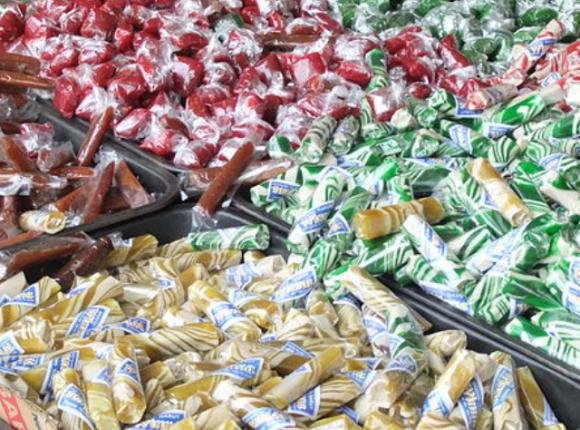
Image Courtesy of: Midori
Dodol is a sweet, toffee-like delicacy made of coconut milk, jaggery (concentrated juice of dates, sugar cane or palm sap), and rice flour. It usually takes up to 9 hours to cook, constantly stirring the concoction. In Indonesia, there are many variations of Dodol, including Dodol Garut, Dodol Durian, Dodol Nangka (jackfruit), Dodol Apel Malang (apple), Dodol Susu (milk), and more.
16. Kue Serabi
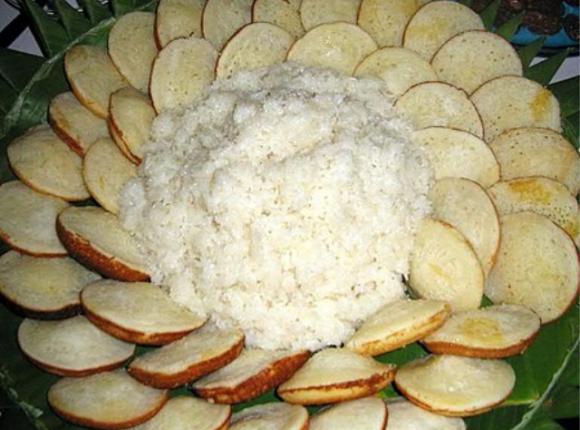
Image Courtesy of: Ivan Lanin
Unlike the ordinary pancakes made for breakfast, Kue Serabi (aka Surabi or Srabi) is more like a snack for the afternoon. This Indonesian pancake is made of rice flour, baking powder, sugar, and eggs, as well as coconut milk or just plain shredded coconut added as an emulsifier, or sometimes pandan leaf added to the batter for a bit of aroma and green color. For a bit of sweetness, they usually serve it with thick golden-brownish coconut or palm sugar syrup.
17. Kue Lupis
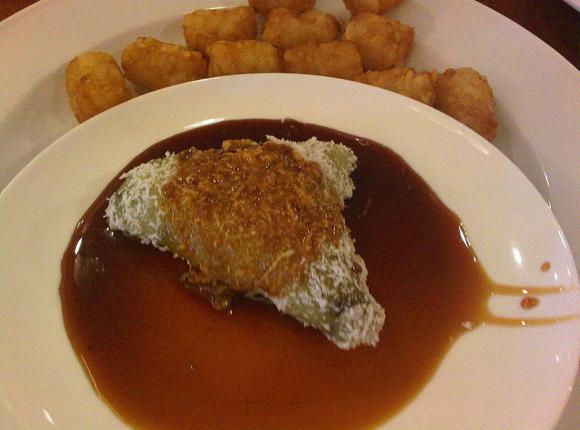
Image Courtesy of: suhakri_hsu
Lupis (pronounced "lopis") is a traditional Indonesian street food made of glutinous rice wrapped and cooked in banana leaves. Grated coconut, complete with a drizzle of thick coconut syrup or a sauce made of palm sugar and pandanus leaf juice, is what gives the snack its sweetness. Surprisingly enough, Lupis is not too sweet after all, and has a nice texture reminiscent of mango sticky rice, only without mango.
18. Getuk
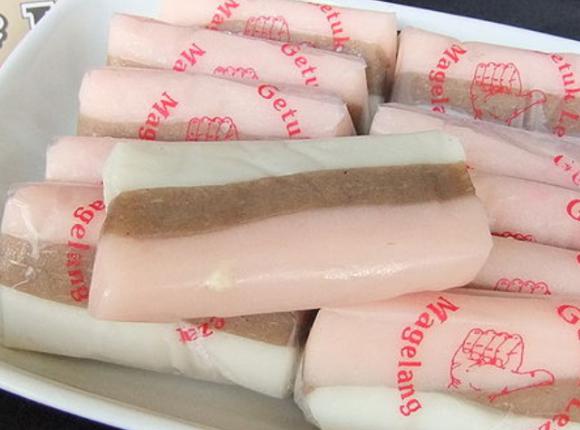
Image Courtesy of: Midori
Getuk is a Javanese snack of various shapes, colors and flavors. Invariably moist and soft in texture, it can be made of either cassava paste and coconut sugar (“Getuk Lindri”), or corn and palm sugar, or sweet potato ("Ubi Jalar"), taro ("Talas") or banana, each mixed with an appropriate type of sugar. For extra deliciousness, Getuk is served with freshly grated coconut.
19. Nagasari
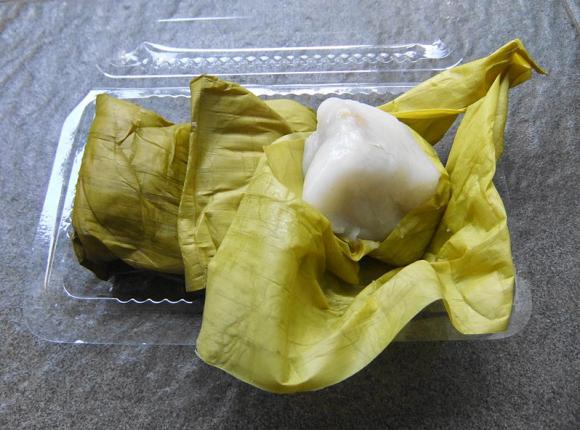
Image Courtesy of: Midori
Good things are often left to be unwrapped, which is very much the case with Nagasari, also known as Kue(h) Pisang, an Indonesian steamed cake made of rice and corn flour mixed with coconut milk. Added with sugar, the patty is then filled with slices of banana and wrapped in banana leaves to steam over a stove until it thickens. The result is a chewy, white confectionery renowned for its soft texture, sweet taste, and a smell of pandan.
20. Pancake Durian
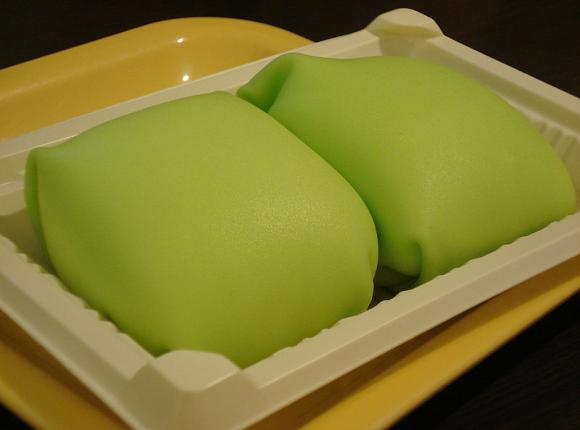
Image Courtesy of: Keilana
Just as the name suggests, the prime difference between an ordinary pancake and a Durian pancake is the presence in it of a Durian fruit. Other (equally and less exotic) ingredients include pandan leaf, wheat flour, eggs, and coconut milk. This dessert is quite easy to make and is best enjoyed with Kopi Tubruk (Indonesian black coffee). Originally from Medan, North Sumatra, Durian Pancake is now very much popular throughout most of Indonesia and the neighboring Southeast Asian countries too.
21. Es Campur
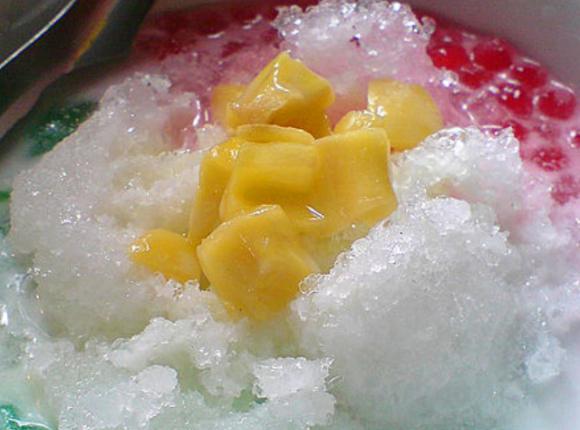
Image Courtesy of: mita1409
Es Campur (literally “ice mix”) is an Indonesian delicacy much loved by the locals – toddlers and elderly alike. The reason is the intricate flavor produced by combination of numerous ingredients such as coconut, nata de coco (chewy, translucent, jelly-like stuff obtained through fermentation of coconut water ), jackfruit, avocado, grass jelly, condensed milk, syrup and more. This stuff is usually considered street food and sold in bags (plastic bags)! Weird but yummy all the same!!!
Get GPSmyCity App for IOS or Android
You can read offline thousands of travel articles like this one in the "GPSmyCity: Walks in 1K+ Cities" app on Apple App Store or Google Play Store. The apps also offer city offline maps and GPS navigation to guide you to the places featured in the articles.
Walking Tours in Jakarta, Indonesia
Create Your Own Walk in Jakarta
Creating your own self-guided walk in Jakarta is easy and fun. Choose the city attractions that you want to see and a walk route map will be created just for you. You can even set your hotel as the start point of the walk.
Jakarta Introduction Walking Tour
The capital of Indonesia, Jakarta, is a massive, fast-paced metropolis and a melting pot of cultures – Asian and European – that historically coexisted and imprinted their influence on the city's architecture, language, cuisine, and lifestyle. The local Istiqlal Mosque is the largest Islamic temple in Southeast Asia, while the Neo-Gothic Gereja Katedral, also known as the Jakarta... view more
Tour Duration: 2 Hour(s)
Travel Distance: 4.1 Km or 2.5 Miles
Tour Duration: 2 Hour(s)
Travel Distance: 4.1 Km or 2.5 Miles
Jakarta's Colonial Buildings
Throughout the centuries, the European powers, particularly the Dutch who colonized Indonesia from the 1800s until 1945, left their mark on Jakarta. At one time known as Batavia, the de-facto capital of the Dutch East Indies, today Jakarta boasts a wealth of old-time structures, featuring a fascinating blend of European and Javanese design influences.
One of the most prominent areas to explore... view more
Tour Duration: 2 Hour(s)
Travel Distance: 2.7 Km or 1.7 Miles
One of the most prominent areas to explore... view more
Tour Duration: 2 Hour(s)
Travel Distance: 2.7 Km or 1.7 Miles


